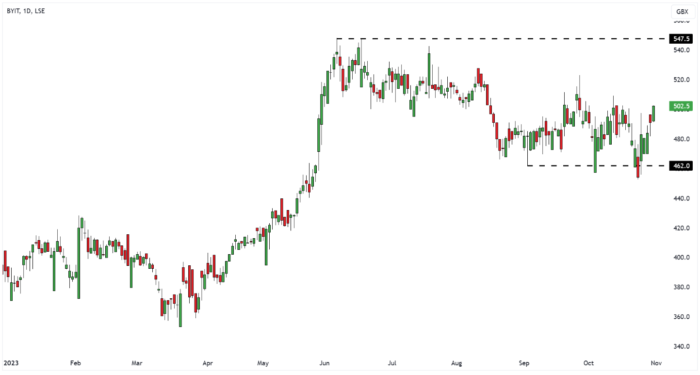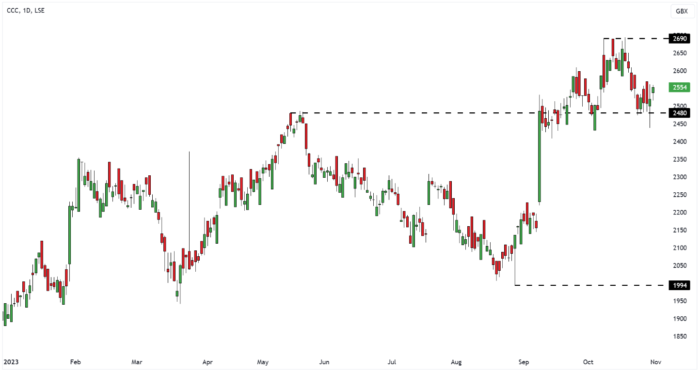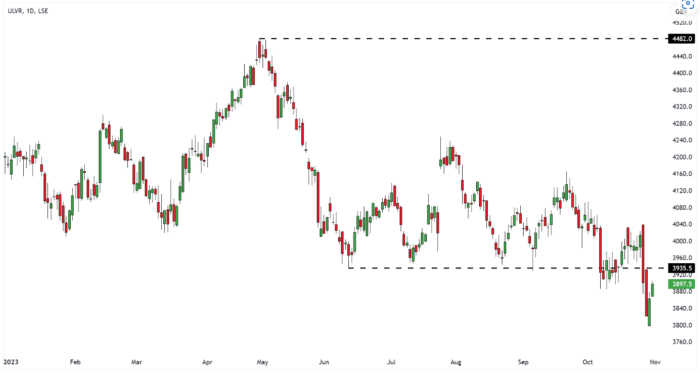1st Nov 2023. 9.02am

Regency View:
Update

Regency View:
Update
Airtel Africa: Strong growth amid currency headwinds
Airtel Africa (AAF) reported robust first-half growth in key performance indicators, with a 9.7% increase in its customer base to 147.7 million customers.
The growth was attributed to the popularity of mobile data and mobile money services, resulting in a 23% surge in data customers and a 23.1% rise in mobile money customers. Average revenue per user (ARPU) increased by 9.8%, and mobile money transactions grew significantly by 45.3%.

Despite a currency devaluation in Nigeria, all segments delivered double-digit constant currency revenue growth. Mobile services revenue increased by 18.3%, and mobile money revenue saw substantial growth of 30.9%.
Airtel Africa’s EBITDA increased by 21.2%, reaching $1.3 billion. However, a loss after tax of $13 million was reported, mainly due to a foreign exchange loss and the impact of the naira devaluation.
Airtel said it remains well-positioned with cash reserves to meet its financial commitments, and the board declared an interim dividend of 2.38 cents per share, aligning with the company’s progressive dividend policy.
The company’s CEO highlighted continued growth opportunities in telecom and mobile money services across its markets. Despite challenges, they aim to improve EBITDA margin in the 2024 financial year.
Barclays gap lower on Q3 numbers
Barclays (BARC) announced a 16% decrease in profit for the third quarter. This decline was primarily attributed to sluggish revenue growth in its UK retail division and lackluster performance in its investment bank, impacted by a shortage of M&A deals and reduced trading activity. However, Barclays managed to exceed expectations by achieving a net profit of £1.3 billion.
The bank also sustained a 5% increase in overall group revenue, reaching £6.3 billion, aligning with market projections. Notably, Barclays allocated fewer funds for bad loans than the market had predicted.
The UK retail division experienced a 3% dip in attributable profit, mainly due to customers shifting deposits away from higher-interest-rate products. Barclays anticipates a decrease in its net interest margin for 2023, now expected to fall within the range of 3.05% to 3.10%, down from the previous guidance of 3.2% to 3.15%. This metric is one to watch, especially with domestic peers like NatWest and Lloyds Banking Group preparing to report their quarterly results soon.

In the investment bank, income decreased by 6% to £3.1 billion when adjusted for a bond overissuance error from last year. Fixed-income trading saw a notable 26% decline, while equity trading revenue more than doubled. Advisory and capital markets fees dropped by 30% due to fewer takeover deals and reduced debt issuance.
The market has responded negatively to Barclays’ Q3 results, causing a share price to gap lower. Prices are now retesting the lows seen during the Silicon Valley banking crisis spike that occurred in March (see chart below).
Bytes Tech reports strong growth and dividend increase
Software company, Bytes Technology (BYIT) reported strong interim results last week.
They saw a 23% increase in pre-tax profit, reaching GBP 33.3 million, and a 16% rise in revenue, totalling GBP 108.7 million for the six months ending August 31.
The company’s CEO, Neil Murphy, attributed this success to robust demand from both corporate and public sector customers for security, cloud adoption, digital transformation, hybrid data centers, and remote working solutions.

Bytes Technology also increased its interim dividend by 13%. The company anticipates the growing importance of Artificial Intelligence products in the IT services sector and believes it is well-positioned to benefit from this trend.
They have a positive outlook for the second half of the 2024 financial year, building on their strong performance in the first half.
Computacenter’s Q3 in-line as tech sourcing volumes return to normal
Computacenter (CCC) reported an in-line set of Q3 numbers on Monday.
In Q3, the company experienced similar trends to the first half of the year, with strong performance in Germany and the US, while the UK market remained challenging.
After experiencing exceptional growth in the first half of the year, Technology Sourcing volumes returned to more normal levels in Q3. This shift occurred as some high-revenue, low-margin projects were completed. Despite this adjustment, the company remains positive about the sales pipeline for Q4.

Computacenter said its services revenue continued to grow during Q3. They are actively managing margin recovery, especially in the face of ongoing inflationary pressures. The company also said it is focused on strategic investments aimed at enhancing its long-term competitive advantage.
Looking ahead, Computacenter is confident that FY 2023 will be another year of progress with growth in profitability. They believe that their strengths in Technology Sourcing, Professional Services, and Managed Services, along with their focus on retaining and maximising long-term customer relationships, position them well to compete and gain more market share.
Keller surpasses expectations with strong Q3 performance
Keller Group (KLR) has reported that its underlying operating profit is expected to exceed current market expectations. The company experienced strong trading throughout the third quarter.
In North America, pricing in Suncoast was more resilient than anticipated, and the foundations business showed sustained operational improvements, leading to strong performance. However, the pricing benefit in Suncoast is expected to decrease in 2024.
In Europe, challenging macro-economic conditions have resulted in weak demand in residential and commercial sectors, affecting profitability. The company continues to be impacted by competitive pricing and the challenges of some projects. The effect of several large successful projects in the previous year also makes for a tough comparison.

As a result, the anticipated profitability improvement in the second half will be less than expected, and the company is taking corrective actions.
In the Asia-Pacific, Middle East, and Africa region, Keller Australia performed well, especially in infrastructure, and Austral returned to profit in the third quarter.
Cash generation for the year exceeded expectations, and the company anticipates a year-end net debt/EBITDA leverage ratio below 1.0x, well within its target range of 0.5x – 1.5x.
Rentokil falls amid economic caution in North America
Rentokil (RTO) had a disappointing third-quarter update, causing the shares to hit a six-month low.
The pest control and hygiene company said headline revenue growth for the quarter was 53%, but it was weaker than their impressive 70% increase in the first half of the year. Furthermore, their underlying growth slowed down from 5.9% in the first half to 4.3% in the third quarter.

The North American market, which accounts for over 60% of their sales, also underperformed, with underlying growth dropping from 4.1% to 2.2%. On the other hand, Rentokil’s primary competitor in the pest control industry, Rollins, posted stronger second-quarter results.
Rentokil’s outlook is a mix of positive progress and caution. They are making good strides with the integration program for Terminix, targeting the delivery of their full-year pre-tax net cost synergy guidance of $60 million year over year. However, they are being cautious about North America, citing macroeconomic uncertainties, which are expected to slightly lower the region’s full-year performance. This, in turn, will affect the projected Adjusted Operating Margin for the region, which is estimated to be in the range of 18.5%-19.0%.
Rentokil’s CEO, Andy Ransom, commented on the trading update, emphasizing their strong fundamentals and global reach:
“The Group delivered a good overall performance in the third quarter. We have a proven, effective strategy to deliver organic growth, focused on strong customer relationships and service quality. In addition, the portfolio effect of our global business operating in multiple markets enables us to weather regional headwinds. The strong fundamentals of our operations are further enhanced by our value-creating M&A programme, led by the integration of Terminix. We are making good progress on the transformation journey and remain confident about the significant value-enhancing benefits.”
Softcat’s strong growth starts to soften
Softcat (SCT) has shown signs of a slowdown as its preferred metric, gross invoiced income, increased by only 2% from the previous year.
The 2.2% growth in gross invoiced income represents a significant slowdown from the 29.4% growth seen the previous year. One reason for this is the absence of a one-off cloud computing contract that accounted for 10% of invoiced income in the prior year. Even without this factor, growth remains sluggish.
Additionally, rising costs have impacted the growth of operating profit, which increased by just 3.5% for the year. A 21.9% rise in operating costs has been driven by factors like wage inflation, increased headcount, and a return to post-COVID-19 travel. Despite these challenges, Softcat’s management remains optimistic, predicting double-digit growth in gross profit for the next year and an operating profit in line with expectations.

In terms of dividends, the company’s board recommends a final dividend of 17.0 pence. This brings the full-year payout to 25.0 pence, reflecting a 4.6% increase. They also announced the continuation of a special dividend of 12.6 pence.
Softcat’s CEO, Graham Charlton commented:
“The company remains in a very strong financial position, and we have great confidence in our long-term growth and cash generation.”
TP ICAP release in-line trading statement
TP ICAP’s (TCAP) total revenue reached £1,644 million for the nine months ending on September 30, showing a 2% increase (4% in reported currency) – in-line with expectations.
This solid performance was attributed to the Energy & Commodities (E&C) division, which benefited from favourable conditions in the energy market across various asset classes.
At the divisional level, Global Broking (GB) revenue decreased by 1% (unchanged in reported currency). This decrease was expected as the exceptional volatility-driven volumes witnessed in 2022 did not reoccur in the first nine months of 2023. In contrast, E&C revenue increased by 16% (19%) with significant growth across the board.

Liquidnet division revenue decreased by 3% (-1%). There was a strong performance from the Relative Value business, but Equities declined in line with subdued block market activity. Liquidnet’s Dealer-to-Client Credit proposition is progressing.
In the third quarter of 2023 (July 1 to September 30), total group revenue was £512 million, up 5% (1%). During this period, GB revenue declined by 2% (6%), following a 12% increase in revenue for the same period the previous year. E&C revenue, on the other hand, saw accelerated growth, increasing by 28% (22%) due to positive market developments and the division’s strong position.
The market reaction to TP ICAP’s numbers has been relatively underwhelming – mirroring a similar reaction to most financial stocks this earnings season.
Unilever’s new CEO fails to inspire the market
Unilever’s (ULVR) new CEO, Hein Schumacher, recently unveiled plans to simplify the company’s operations. This involves a focus on 30 key brands that make up 70% of its sales. Although the company met third-quarter sales growth expectations, it struggled to win back customers who had shifted to cheaper products due to rising living costs.
Unilever reported a 5.2% increase in underlying sales for the third quarter. Prices rose by 5.8%, while volumes decreased by 0.6%. This price increase was higher than analysts expected, and they had also anticipated that volumes would rise for the first time in about two years, which did not happen, particularly in Europe where volumes were down 10.7%.
Alongside the Q3 numbers, Unilever also announced a change in senior leadership, appointing Fernando Fernandez, the current president of the beauty and wellbeing business, as the new Chief Financial Officer.

Despite these efforts, Unilever’s share price fell to a year-low following the update, with investors unimpressed by the company’s new strategy, as they didn’t find it to be a significant departure from previous approaches.
Disclaimer:
All content is provided for general information only and should not be construed as any form of advice or personal recommendation. The provision of this content is not regulated by the Financial Conduct Authority.









